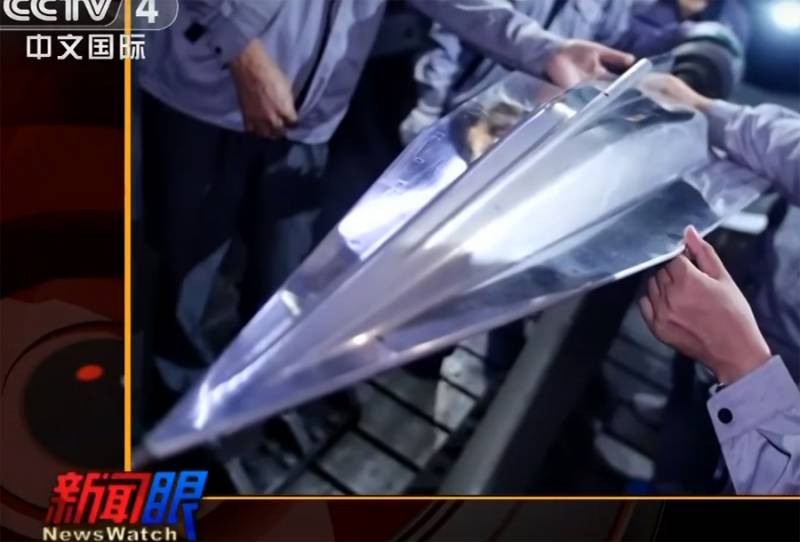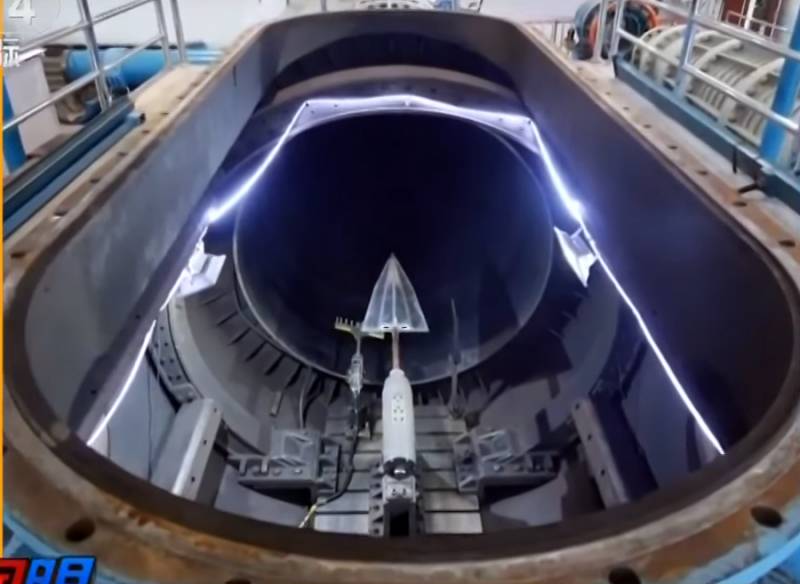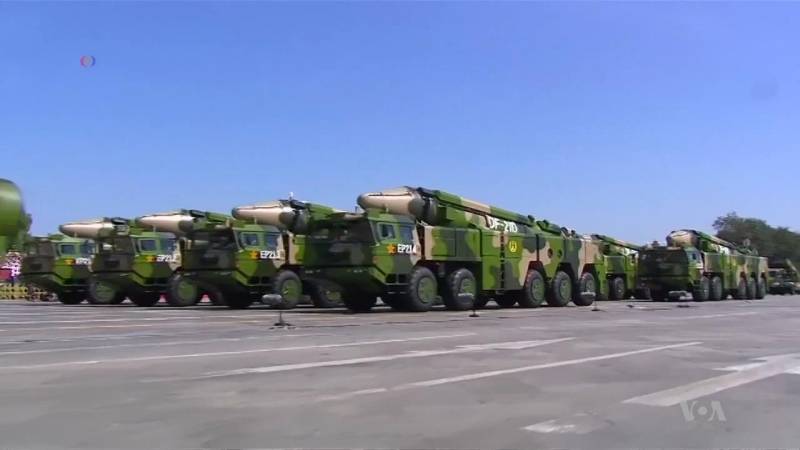Project WU-14 / DF-ZF. China masters hypersound
The existence of the Chinese project of a hypersonic shock aircraft became known a few years ago. The Chinese army and defense industry traditionally do not rush to reveal the details of their promising projects, and therefore the existence of a ready-made hypersonic device became known only after the first test launch, at the beginning of 2014. In the future, the Chinese and foreign press repeatedly extracted and published new information about a promising project.
For obvious reasons, China did not even disclose the official name of its draft hypersonic aircraft. In this regard, for some time the project wore the symbol WU-14, assigned to it by American intelligence. Later, new designations applied to the same project. Now a promising product called the DF-17 or DF-ZF.
About four years ago it became known not only about the existence of the project, but also about the conduct of the first trial launch. According to news the beginning of 2014 of the year, 9 of January was the first flight of the WU-14 product. Reports of the start of tests of the Chinese hypersonic glider first appeared in the foreign press, and soon official Beijing confirmed them. At the same time, as noted by the Chinese Ministry of Defense, the launch was of an exclusively research character and was not part of a certain military project. However, experts and the press, not without reason, doubted the veracity of such clarifications.
According to foreign media reports, in 2014, China conducted two more test flights of the WU-14 / DF-ZF product. The second trial launch took place on August 7, the third on December 2. It should be noted that at that time various specialized publications could report only on the fact of launches, as well as on the sites on which they were held. Other details were missing: speed and range, as well as the main findings of the testers remained unknown.
In the 2015, the new test launches of the hypersonic device were reported twice. The fourth in a series of test launches conducted on June 7. The fifth start took place on November 27. For some reason, later launches of DF-ZF have become a rare event. So, in 2016, China conducted only one test: a prototype passed along a given route in April. The latest verification at the moment (or, according to other data, verification) was held in November last year. According to different sources, at the end of the fall of 2017, one or two test runs took place.
Only a few years after the start of the project and the start of test flights, did the Chinese defense industry publish the appearance of a promising aircraft. In early October last year, the state television channel CCTV showed a report on new developments for the army, including the hypersonic arms. In the report, several large-scale mockups were demonstrated, in which foreign intelligence services and specialists identified models of the new hypersonic weapon. Among the samples shown, the WU-14 / DF-ZF mockup was also present.
As in the recent past, most of the technical information was not published, but a demonstration of the layout of a hypersonic glider makes it possible to solidly complement the existing picture. Perhaps in the future there will be new confirmed information that will allow a more complete analysis of the situation and clarify the existing findings.
The Chinese project DF-ZF provides for the construction of a hypersonic aircraft of special forms characteristic of this kind of technology. The construction of a low-wing glider with a delta wing of minimum elongation is proposed. From the upper surface of the wing of the presented model, the fuselage with a quadrangular cross section literally grows, featuring a small height and width. The project also provides for the use of rudimentary vertical tail, having the smallest possible size.
What is inside the fuselage and the wing of such a glider is unknown. It can be assumed that for the tests used layouts of different designs with different internal content. So, at the stage of testing in a wind tunnel, it was possible to do without any of our own equipment models, but much more complex prototypes should be involved in flight tests.
Apparently, the experienced WU-14 / DF-ZF, which have so far performed seven or eight test flights, carry their own navigation equipment and control devices. In addition, they must contain monitoring and recording devices and means of transmitting data to the ground. In the course of further development, the combat version of the hypersonic apparatus will have to receive the warhead. What type of charge will be used - so far it remains only to guess.
According to known data, test launches of DF-ZF / DF-17 products were carried out using modified serial missiles. With their help, the prototype was displayed on a predetermined path and accelerated to the required speed. Then the hypersonic device was dropped and continued to fly independently, in accordance with the program entered. The type of launch vehicle is unknown, but speculations were made about the possible use of one of the latest ballistic missiles.
According to various estimates, in the future, after being put into service, the DF-ZF system can become a full-fledged combat equipment of several ballistic missiles created in recent years. The People’s Liberation Army of China has recently received several medium-range and intercontinental missile systems, each of which, at least in theory, can be equipped with a new warhead in the form of a hypersonic aircraft. The lack of accurate information about the dimensions and mass of a full-fledged combat WU-14 / DF-ZF does not yet allow narrowing the circle of "applicants" for the position of its carrier.
In some analyzes, a medium-range ballistic missile of the DF-21 family is considered as a possible carrier of hypersonic combat equipment. As part of this line, several missiles were developed that can send a warhead to a distance of 1700-2700 km. The weight of the combat load reaches several hundred kilograms. There is reason to believe that the use of a hypersonic aircraft capable of planning in the atmosphere can significantly increase the combat radius of the missile complex in comparison with the "traditional" free-fall war blocks. In this case, the DF-21 rocket will be able to attack targets at distances of the order of 2-3 thousand km or more.
Another potential carrier DF-ZF / DF-17 can be considered an intercontinental ballistic missile DF-31. Various modifications of such a product have a range of 8 or 11 thousand. Km. Proper use of the energy parameters of the rocket in combination with the use of a hypersonic glider will significantly increase the firing radius. In the same role, the DF-41 complex can also be used, which in its present form can hit targets at ranges of at least 12 thousand km.
Some of the missile systems, considered as possible carriers of hypersonic military equipment, were initially made mobile. Thus, a modified complex with a fundamentally new warhead receives a number of characteristic capabilities. The lack of “binding” to a specific object and the possibility of launching a rocket right on the patrol route to a certain extent increases the combat capabilities and potential of the complex, regardless of the type of combat equipment.
The Chinese military and engineers are in no hurry to disclose accurate information about the characteristics of future weapons, which is why in this area so far it is necessary to rely only on various estimates. Thus, in the context of the WU-14 / DF-ZF project, the possibility of gliding the glider to a speed that was 5-10 times the speed of sound was mentioned earlier. Thus, the aircraft can reach speeds from 6100 to 12300 km / h. However, these are only estimates, and the actual characteristics of the aircraft can be much more modest than expected.
It is obvious that the value of the maximum speed of a hypersonic device, which does not have its own power plant, will be directly related to the type of launch vehicle and its characteristics. The speed of the airframe and, as a result, the range of its independent flight directly depend on the characteristics of the rocket, ensuring its acceleration and output to a predetermined trajectory. Thus, a medium-range ballistic missile will accelerate the aircraft worse than the intercontinental, which has higher energy performance.
Since the appearance of the first information about the WU-14 project, specialists have been trying to predict the purpose of the finished glider. First of all, it is considered a more convenient and effective replacement of the warheads of ballistic missiles, which has a number of characteristic features. Planning will provide a certain increase in the firing range, as well as allow combat equipment to maneuver. Due to the possibility of performing maneuvers on a descending flight segment, such a combat unit will prove to be an extremely difficult goal for anti-missile anti-missile systems. The loss of shock weapons from missile defense will be reduced, and the effectiveness of a nuclear missile strike will increase.
A few years ago, China introduced its first anti-ship ballistic missile DF-21D, which also became the world's first representative of this unusual class of weapons. Shortly after the appearance of the first reports of the existence of a Chinese hypersonic program, attempts began to predict the future of the WU-14 / DF-ZF product as a weapon to fight the enemy ships. As in the case of other issues, the possibility of using a hypersonic airframe as part of the new RCC has not yet been officially confirmed and not denied.
The main objective of the project of a ballistic anti-ship missile DF-21D was considered to be the search for the target and the guidance of the combat unit when moving along the descending part of the trajectory. A number of characteristic features of ballistic missiles interfered with the effective solution of such tasks. A hypersonic glider capable of maneuvering along a trajectory is spared from some similar problems. However, due to similar flight conditions, namely the difficulty or even impossibility of radio exchange and the minimum flight time, the use of DF-ZF against moving surface targets remains an extremely difficult task.
According to known data, as part of its hypersonic program, China has created several new projects, and at least one of them has already reached the stage of flight tests. Model samples of the model WU-14 / DF-ZF seven or eight times took off into the air using a carrier and then carried out the flight program, collecting all the necessary data. The number of known tests can show how far Chinese specialists have managed to go. Developing the achieved successes and continuing to improve the already existing products, in the foreseeable future they will be able to complete the experimental part of the project and provide the army with a full-fledged complex suitable for combat use.
According to various estimates, the hypersonic glider of the new model, ready for operation in the army, will be created and put into service no later than the beginning of the next decade. Perhaps it was after 2020, the People’s Liberation Army of China, trying to intimidate a potential adversary, will publish basic information about its new weapons, which will once again complement the existing picture.
Currently, all the leading countries of the world are studying the subject of hypersonic rockets and planning aircraft. Such products can be used in different areas of military affairs and solve various tasks, primarily of a striking character. China does not want to lag behind other countries that have already created their projects, and therefore is also trying to master a new direction. As the reports of recent years, he succeeds.
On the materials of the sites:
http://globalsecurity.org/
http://janes.com/
http://freebeacon.com/
http://nevskii-bastion.ru/
https://thediplomat.com/
http://spacedaily.com/
http://military.china.com/



Information